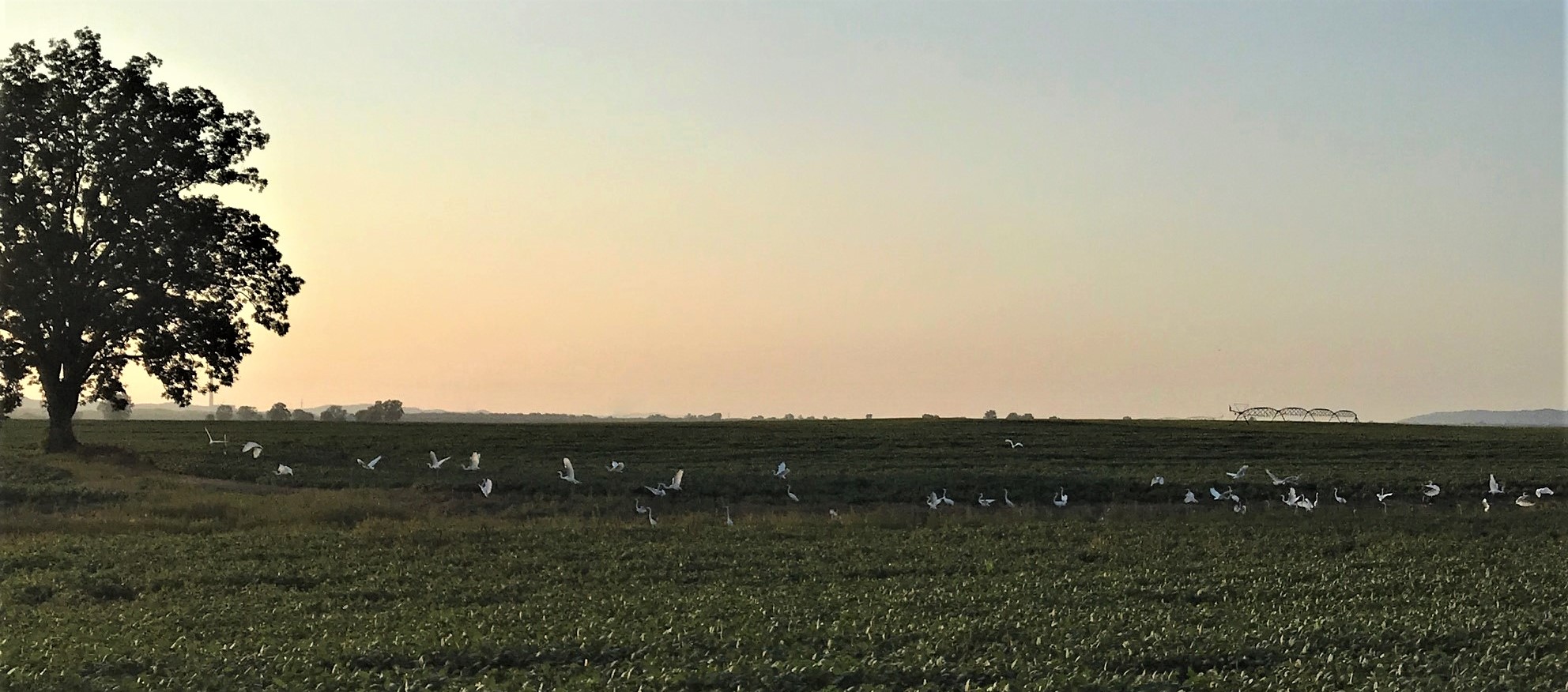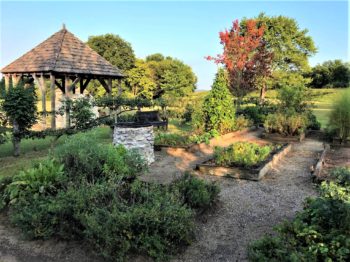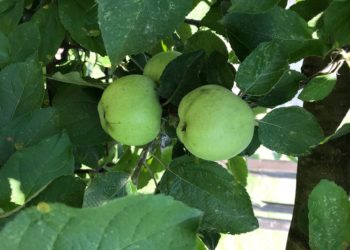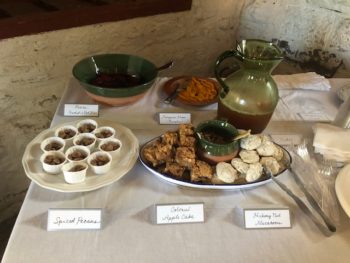
29 octobre 2020 jeudi
45 degrees, rain
10-20 mph, NNW wind
As the mantle of autumn settles across the American Bottom, the rhythm of nature and the region’s harvesting of crops heralds the end of the growing season, bringing with it a sense of calm and order. Everywhere garden beds and farmland are preparing for their winter dormancy, while the autumn potager plantings slowly make their way to their final harvest. In a year filled with chaos and uncertainty, nature provides a path and a quiet space for our consciousness to regroup and contemplate. We are given this opportunity to rediscover balance and purpose through the simple autumn observations of nature and the seasonal garden tasks yet to be completed.
Work to be done in November
They who have trees to Plant in a light or free Earth, which is neither hot or cold, must not fail to do so this Month. Omit not neither to have some Dung laid over the Earth at the Foot of each Tree you Plant.
When the Stalks of Asparagus are in Seed, you must not cut them till the Seed is grown red – if you do it sooner the Seed will be spoil’d, and the Plants themselves produce only small sorry shoots in the Spring…
To preserve Winter Roots, as Red Beets, Carrots, and Parsnips, chuse a fine day and take ‘em out of the Ground, with the Earth about ‘em, then carry them into the Place where you intend to keep ’em, laying them one one by another, to take them as you have Occasion…
We Raise small Salleting on Hot Beds, which cannot be well done without Glass Frames or Bells
We sow Peas in some warm sheltered Place, to have em very early, but they must be covered during the Frost.
This is the Month when we make the Operation upon Old Trees, of cutting off some great Root to make ‘em bear Fruit. It may likewise be done in December and January.
-Francois Gentil, Le jardinier solitaire. 1706
 The beginning of the autumn season brought warm weather and sunny skies, perfect conditions to gather the garden’s heirloom produce, seeds, and its largest crop yet of heritage apple and pears. October’s recent frosts and colder weather have brought an end to the last harvests of Cornfield beans, Bull Nose peppers, and Listada de Gandia eggplants. As the more hectic garden work subsides, now time is spent gathering the last seeds for next year and finish cleaning up spent frost-bitten crops while nourishing and tending the fall-planted, cold-hardy vegetables. These autumn vegetables are chosen for their cold tolerance and shorter growing season, such as cabbage, carrot, kale, leeks, lettuce, peas, radishes, and spinach.
The beginning of the autumn season brought warm weather and sunny skies, perfect conditions to gather the garden’s heirloom produce, seeds, and its largest crop yet of heritage apple and pears. October’s recent frosts and colder weather have brought an end to the last harvests of Cornfield beans, Bull Nose peppers, and Listada de Gandia eggplants. As the more hectic garden work subsides, now time is spent gathering the last seeds for next year and finish cleaning up spent frost-bitten crops while nourishing and tending the fall-planted, cold-hardy vegetables. These autumn vegetables are chosen for their cold tolerance and shorter growing season, such as cabbage, carrot, kale, leeks, lettuce, peas, radishes, and spinach.
Earlier in the year, the Fort de Chartres jardin potager experienced another stretch of challenging, damp, and cool weather in the spring and early summer. The garden finally hit full stride mid-summer as the weather eventually warmed and settled. The warm seasonal crops of beans, cucumbers, and squash proved bountiful and just in time to welcome returning garden visitors. The autumn season brought warm weather and sunny skies, perfect conditions to gather the garden’s heirloom produce, seeds, and its largest crop yet of heritage apple and pears. As always to be found in any garden year, there are still plants that thrive and those that fail. Over and over, spring seeds of lettuce, bush beans, and beets along with other root crops were planted, only to never really flourish, and it was a relief to welcome the arrival of late summer to begin anew with the planting of the fall garden. Now, these final remaining autumn crops will be nourished, cherishing the life and energy they bring to the now sleepy jardin potager.

Calville Blanc Apples
As previously mentioned, the garden’s apple and pear trees offered a fine harvest this past growing season. These French heirloom varieties were picked in September and early October and allowed to fully develop their flavor in cold storage for a few months. This fall has been a wonderful time to bake, preserve, and experiment with these garden jewels. The kitchen has been filled with the lovely fragrance of fall cakes, fruit desserts, and cider, certainly comforting in these recent dreary days. Using some of our earlier harvest of Anjou and White Doyenne pears, a centuries-old French dessert standard of Stewed Pears in Red Wine was prepared. And for the first time since the trees began to bear fruit, there were enough apples from our heritage Fameuse, Calville Blanc, and Summer Rambor trees to try making some homemade cider (unfermented), with a light and lovely result. If one wants to add a bit of bourbon or brandy to liven the taste, no judgment will be offered here. These autumn recipes and other desserts, and a bit of their history, can be found on this website’s Recettes page by clicking Recettes 2020.

An Autumn 18th Century Taste Recettes Photo Pascale Kichler
In the French colonial home, fruit was often preserved with sugar, and if left long enough, the fruit would ferment. Ciders, vinegar shrubs, and other fruit vinegars were additional methods of preserving fruit harvests beyond drying or the making of jams and jellies. Frugality was an essential component of survival in French or other colonial households; thus, all parts of the fruit were utilized. The peels and other fruit detritus could be combined with water and some sweetener such as sugar or maple syrup, and after a few months of fermenting in the warmth near a hearth, one would have a basic fruit vinegar. These vinegars would have benefit all winter-long for the use in the preparation of foods and other household activities.
Taking a lesson from the Illinois Country’s garden history, perhaps there is a glimmer of light and more than a small bit of art to be found in the sustenance of the everyday jardin potager and its seasonal tasks. To make something delicious and sustaining from whatever our gardens (or life) offers us in any given season, gives real meaning and purpose to our journey. Best wishes for everyone’s good health, and may you experience the hope and healing solace that can be discovered in nature and one’s own garden. A bientôt!
NOTE: Recent summer and fall jardin potager visitors have inquired if there was a place online to donate to this heritage garden project. A sincere thank you is owed to Les Amis du Fort de Chartres, for they have created a garden donation link that benefits the Fort de Chartres Heritage Garden Project. Many thanks to all who support this independent heritage garden project and its mission to share the rich French Colonial and Native Peoples foodway history and the heirloom seeds that illustrate and preserve this story. Merci, your support is gratefully appreciated! And don’t forget-my French Colonial Heritage Garden Seed Collections are available online at Les Amis du Fort de Chartres Heart of Illinois Artisan Heritage Shop.
Leave a Reply